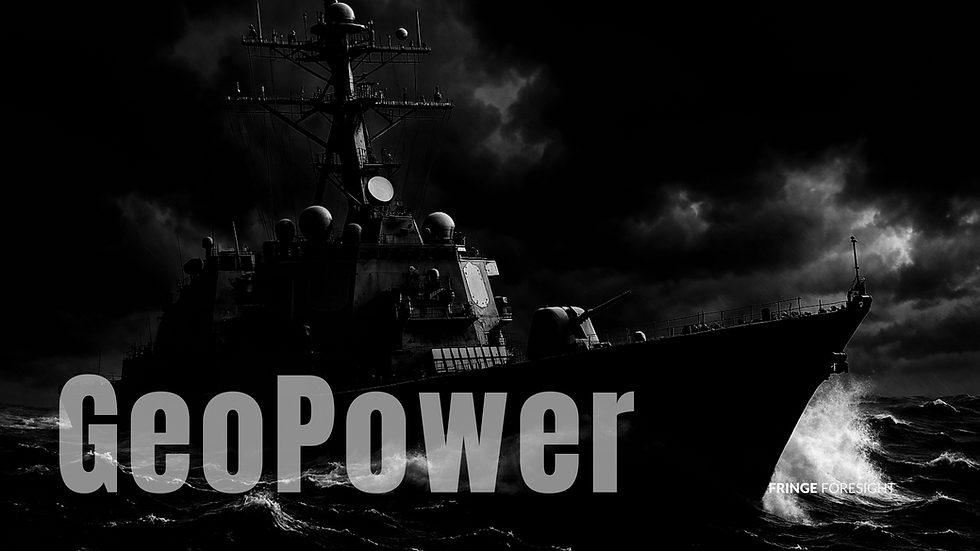GeoPower Oct 2025
- Fringe Foresight

- Sep 26
- 3 min read
Updated: Oct 13

Geopolitical tensions, national defense strategies, and trade dynamics are converging into a volatile new system where power is increasingly contested. From shifting alliances to technological competition, the global order is being rewritten in real time.
At Fringe Foresight, we track this evolving space under the domain Geopower, which examines the militarization of new technologies, the fragility of supply chains, and the contest for strategic dominance.
Our latest Trend Analysis Report highlights the drivers reshaping geopolitics, the disruptions on the horizon, and the weak signals that could foreshadow future systemic shocks. What follows is the Executive Summary—a preview of the insights available in the full report.
For the complete analysis, including signals, disruptions, and strategic implications, download the full report *here.
Executive Summary
Over the past several months, the GeoPower domain reveals a sharp acceleration toward resource securitization, techno-sovereignty, and hybrid conflict architectures. States are treating supply chains, information systems, and demographic trajectories as strategic terrain equal to military assets. The framing of “sovereignty” has expanded from borders and firepower to include control over compute, minerals, narratives, and resilience infrastructures. This broadening is reconfiguring both power projection and vulnerability management.
The Rise of Hybrid Conflict
Meanwhile, hybrid and iterative conflict has become normalized. Military adaptation cycles are compressing, with tactics from proxy wars rapidly absorbed into major doctrines. For example, the U.S. Air Force has adopted Ukrainian drone tactics. Influence operations are scaling through AI-driven proxies, such as generative AI disinformation and AI-powered disinformation networks. These developments erode predictability in both battlefield and political arenas, creating a persistent state of “strategic ambiguity.”
Financial Instruments of Power
What remains relatively stable is the use of financial and monetary levers as instruments of power. From central banks’ gold accumulation to parallel payment experiments, economic statecraft is functioning as a quieter but durable axis of competition. At the same time, signals of demographic strain and grassroots political mobilization—such as Canada’s population plateau and Indigenous climate sovereignty campaigns—highlight undercurrents that may become more disruptive if left unaddressed. Overall, GeoPower is shifting toward a polycentric, adaptive contest, where resilience, narrative control, and infrastructure sovereignty carry as much weight as military arsenals.
Fragmented Resource Politics
Two dynamics stand out. First, fragmented resource politics is displacing assumptions of global efficiency. Signals such as India’s pursuit of African rare earths, Redwood Materials’ battery stockpiling, and Burkina Faso’s mine nationalizations show a decisive move toward the securitization of minerals, energy, and circular infrastructures. Access—rather than abundance—is emerging as the organizing principle of Geopower.
The Intensification of Techno-Nationalism
Second, techno-nationalism is intensifying, not only among great powers but also through smaller states leveraging quantum, crypto, and localized production systems as force multipliers. For instance, Bhutan’s sovereign crypto and Quantum-Systems’ 3D drone printing are examples of this trend. This disperses influence and complicates traditional deterrence models.
Meta Trends
Resource Sovereignty Wars (accelerating)
Technonationalism 2.0 (accelerating)
Hybrid & Iterative Conflict (accelerating)
Economic Statecraft Realigned (stable, with emerging alternatives)
Resilience as Security (emerging)
Conclusion
As we navigate these complex dynamics, it is crucial for leaders and decision-makers to stay informed. Understanding the evolving landscape of geopolitics will empower you to make strategic decisions with confidence. By recognizing the interplay between technology, resources, and military strategy, you can better prepare for the challenges ahead.
The future is not just about reacting to change; it is about proactively shaping it. Embrace the insights from our Trend Analysis Report to guide your strategic planning and ensure your organization thrives in this new geopolitical environment.


Comments